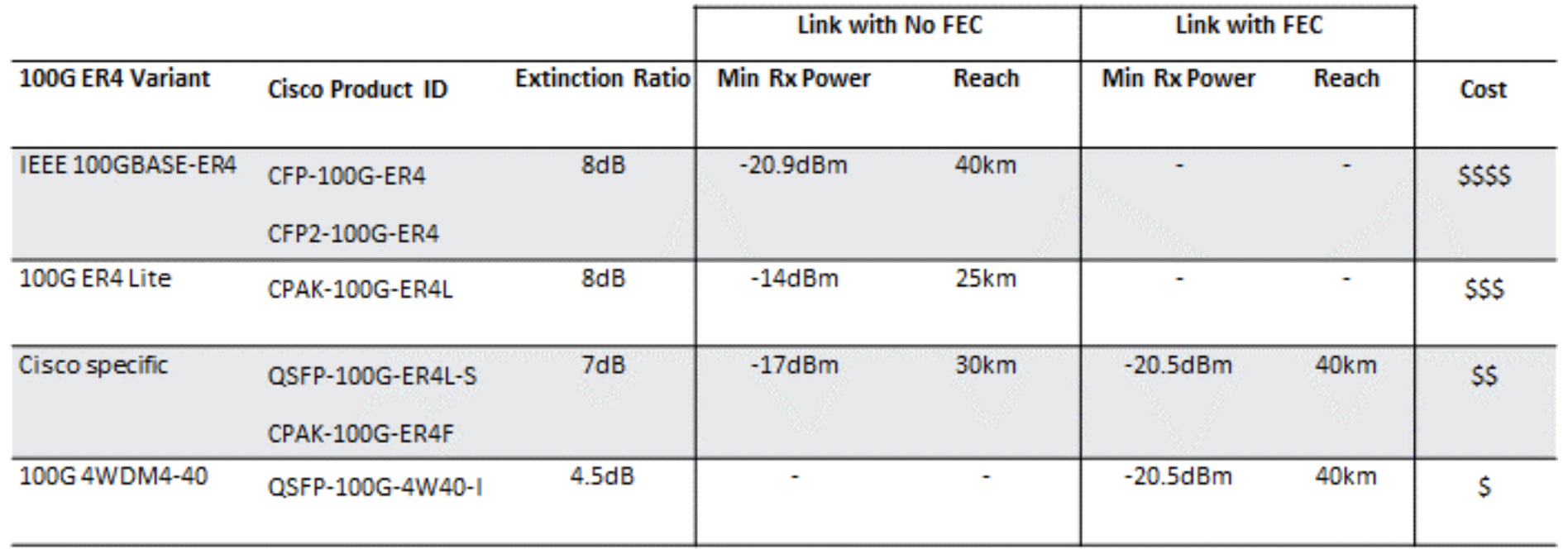Subscribe to the Cisco Optics Blog 
Written by Jose Raygoza, Product Manager, Cisco Transceiver Modules Group
Since the introduction of 100G pluggable optics several years ago, a great variety of reaches and form factors became available.
Among the most confusing reaches are the Extended Reach variants. In this blog, we are going to explain what variants are available in the Cisco Optics portfolio, and the differences between them.
100G Extended Reach
Extended Reach Optics usually refer to optics that can achieve transmission distances of up to 40km over single-mode fiber.
The first 100G Extended Reach variant available in the market in a pluggable form factor was CFP 100G ER4. This variant was based on the IEEE 802.3ba standard, with a power consumption of roughly 24W.
The high power and low faceplate density (due to large size) prevented its use on several applications. So a second Extended Reach variant, known as “ER4L” or “ER4 Lite”, hit the market in form factors like CPAK and CFP2, lowering the power to roughly 8.5W. This solution enabled higher density applications, but the trade-off was that the maximum transmission distance was only 25km.
Finally, a third flavor emerged in the QSFP28 form factor: 4WDM-40 and ER4L with host FEC (Forward Error Correction). It reduced the power consumption further to less than 5W. But unlike the ER4L variant, it can reach 40km. This is possible because it relies on the host port to run FEC to improve BER (Bit Error Rate) over a noisy channel.
Specifications comparison
Table 1 summarizes some relevant parameters of the Extended Reach variants.

There is a general relation between the cost and performance of the components. The higher the laser modulation extinction ratio, the higher the modulation performance required. And the lower the minimum receiver power, the higher the receiver performance required.
Also, the use of FEC helps to relax the specifications, making designs less expensive.
Table 1 shows how cost is different across the variants. Intuitively, we can see how the cost increases as the design requires higher performance components.
Interoperability
As can be inferred from the previous section, not all solutions are interoperable. Table 2 summarizes the interoperability between different extended reach variants.

Which one should I use?
Some of these variants are only available in certain form factors. For example, the 100GBASE-ER4 versions, which consume high power, are only feasible in large form factors like CFP. Also, any variant that leverages FEC on the host platform is only available in the QSFP28 form factor or future form factors, as previous form factors didn’t require host FEC in their specifications.
Therefore, the variant that you should use is determined first by the availability of the specific form factor you have in your host platform or line card, and second by the interoperability requirement on the other side of your link.
If there are no interoperability constraints, your best bet is one of the ER4 variants that have the help of FEC, as they are able to provide the full reach (40km) with less power.
Subscribe to the Cisco Optics blog!
And don’t forget to watch the Cisco Optics Youtube playlist.

Finally, a 40km CPAK!!